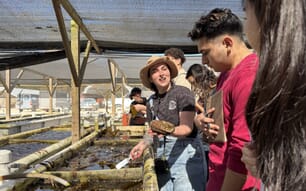
The new project aims to secure a supply of juvenile wolffish from wild-caught broodstock, which will then be released in northern Norway in order to reduce sea urchin numbers © Oliver Sandaa
Along the coast of northern Norway, past coastal fisheries removed predatory fish, including Atlantic wolffish, that had previously controlled sea urchin populations. This triggered an ecosystem collapse during the 1970s, when kelp forests were grazed down by urchins into barren ground.
The Atlantic wolffish stocks have failed to recover, probably due to late sexual maturity (6–7 years) and limited connectivity between local populations, but Restorae and Trefadder/Vår Energi have now allocated sufficient funding to Akvaplan-niva and the Norwegian Institute for Water Research (NIVA), to produce 500 Atlantic wolffish juveniles from wild caught broodfish, available for pilot experiments, and controlled release into the wild.
Applications of release permissions and fishery protection will be conducted as part of the provided funding and it also covers the collection of tissue samples (muscle or fin-clip) from 50-100 individual Atlantic wolffish from 3-4 separate geographic areas/fjords along the coast of Troms and Finnmark to prepare for future analysis of the Atlantic wolffish genetic population structure (pending financing).
Akvaplan-niva and NIVA are responsible for defining the scientific work and interpreting the scientific results from the project, including any follow-up steps to be defined and sought financing for during/after the project period. Akvaplan-niva is responsible for the Atlantic wolffish throughout the project period, and their destiny after the end of the project.
Meanwhile the project’s steering committee consists of Brian Tsuyoshi Takeda (Restorae), Øyvind Stråbø (Trefadder), Erling Natvig (Vår Energi), Camilla With Fagerli (NIVA) and Marianne Frantzen (Akvaplan-niva).




